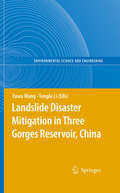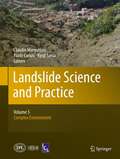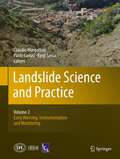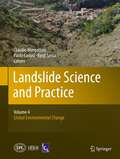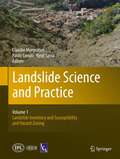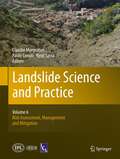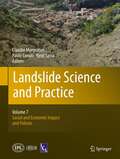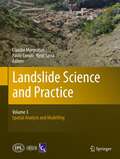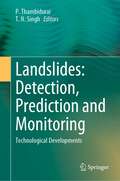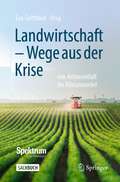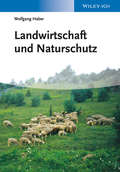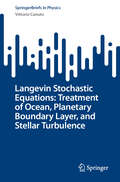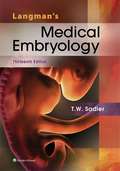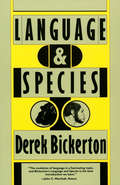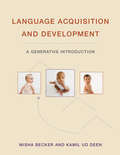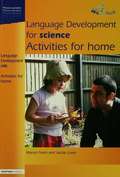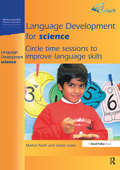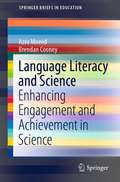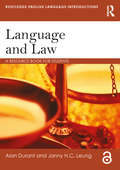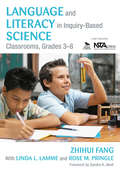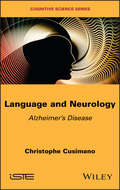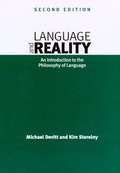- Table View
- List View
Landslide Disaster Mitigation in Three Gorges Reservoir, China
by Tonglu Li Fawu WangThis book presents the research results on landslide disaster mitigation in Three Gorges Reservoir, China. It consists of three parts. (1) Regional properties of landslides in this area, (2) Case studies about some typical landslides, and (3) New methodologies applied in this area. It provides useful information to academics, practitioners, and university students working on landslide disaster mitigation, especially for large engineering projects. This book can also be used as an information source for geo-hazards in the Three Gorges Reservoir Area.
Landslide Ecology
by Lawrence R. Walker Aaron B. ShielsDespite their often dangerous and unpredictable nature, landslides provide fascinating templates for studying how soil organisms, plants and animals respond to such destruction. The emerging field of landslide ecology helps us understand these responses, aiding slope stabilisation and restoration and contributing to the progress made in geological approaches to landslide prediction and mitigation. Summarising the growing body of literature on the ecological consequences of landslides, this book provides a framework for the promotion of ecological tools in predicting, stabilising, and restoring biodiversity to landslide scars at both local and landscape scales. It explores nutrient cycling; soil development; and how soil organisms disperse, colonise and interact in what is often an inhospitable environment. Recognising the role that these processes play in providing solutions to the problem of unstable slopes, the authors present ecological approaches as useful, economical and resilient supplements to landslide management.
Landslide Science and Practice: Complex Environment
by Claudio Margottini Kyoji Sassa Paolo CanutiThis book contains peer-reviewed papers from the Second World Landslide Forum, organised by the International Consortium on Landslides (ICL), that took place in September 2011. The entire material from the conference has been split into seven volumes, this one is the fifth: 1. Landslide Inventory and Susceptibility and Hazard Zoning, 2. Early Warning, Instrumentation and Monitoring, 3. Spatial Analysis and Modelling, 4. Global Environmental Change, 5. Complex Environment, 6. Risk Assessment, Management and Mitigation, 7. Social and Economic Impact and Policies.
Landslide Science and Practice: Early Warning, Instrumentation and Monitoring
by Claudio Margottini Kyoji Sassa Paolo CanutiThis book contains peer-reviewed papers from the Second World Landslide Forum, organised by the International Consortium on Landslides (ICL), that took place in September 2011. The entire material from the conference has been split into seven volumes, this one is the second: 1. Landslide Inventory and Susceptibility and Hazard Zoning, 2. Early Warning, Instrumentation and Monitoring, 3. Spatial Analysis and Modelling, 4. Global Environmental Change, 5. Complex Environment, 6. Risk Assessment, Management and Mitigation, 7. Social and Economic Impact and Policies.
Landslide Science and Practice: Global Environmental Change
by Claudio Margottini Kyoji Sassa Paolo CanutiThis book contains peer-reviewed papers from the Second World Landslide Forum, organised by the International Consortium on Landslides (ICL), that took place in September 2011. The entire material from the conference has been split into seven volumes, this one is the fourth: 1. Landslide Inventory and Susceptibility and Hazard Zoning, 2. Early Warning, Instrumentation and Monitoring, 3. Spatial Analysis and Modelling, 4. Global Environmental Change, 5. Complex Environment, 6. Risk Assessment, Management and Mitigation, 7. Social and Economic Impact and Policies.
Landslide Science and Practice: Landslide Inventory and Susceptibility and Hazard Zoning
by Claudio Margottini Kyoji Sassa Paolo CanutiThis book contains peer-reviewed papers from the Second World Landslide Forum, organised by the International Consortium on Landslides (ICL), that took place in September 2011. The entire material from the conference has been split into seven volumes, this one is the first: 1. Landslide Inventory and Susceptibility and Hazard Zoning, 2. Early Warning, Instrumentation and Monitoring, 3. Spatial Analysis and Modelling, 4. Global Environmental Change, 5. Complex Environment, 6. Risk Assessment, Management and Mitigation, 7. Social and Economic Impact and Policies.
Landslide Science and Practice: Risk Assessment, Management and Mitigation
by Claudio Margottini Kyoji Sassa Paolo CanutiThis book contains peer-reviewed papers from the Second World Landslide Forum, organised by the International Consortium on Landslides (ICL), that took place in September 2011. The entire material from the conference has been split into seven volumes, this one is the sixth: 1. Landslide Inventory and Susceptibility and Hazard Zoning, 2. Early Warning, Instrumentation and Monitoring, 3. Spatial Analysis and Modelling, 4. Global Environmental Change, 5. Complex Environment, 6. Risk Assessment, Management and Mitigation, 7. Social and Economic Impact and Policies.
Landslide Science and Practice: Social and Economic Impact and Policies
by Claudio Margottini Kyoji Sassa Paolo CanutiThis book contains peer-reviewed papers from the Second World Landslide Forum, organised by the International Consortium on Landslides (ICL), that took place in September 2011. The entire material from the conference has been split into seven volumes, this one is the seventh: 1. Landslide Inventory and Susceptibility and Hazard Zoning, 2. Early Warning, Instrumentation and Monitoring, 3. Spatial Analysis and Modelling, 4. Global Environmental Change, 5. Complex Environment, 6. Risk Assessment, Management and Mitigation, 7. Social and Economic Impact and Policies.
Landslide Science and Practice: Spatial Analysis and Modelling
by Claudio Margottini Kyoji Sassa Paolo CanutiThis book contains peer-reviewed papers from the Second World Landslide Forum, organised by the International Consortium on Landslides (ICL), that took place in September 2011. The entire material from the conference has been split into seven volumes, this one is the seventh: 1. Landslide Inventory and Susceptibility and Hazard Zoning, 2. Early Warning, Instrumentation and Monitoring, 3. Spatial Analysis and Modelling, 4. Global Environmental Change, 5. Complex Environment, 6. Risk Assessment, Management and Mitigation, 7. Social and Economic Impact and Policies.
Landslides: Technological Developments
by T. N. Singh P. ThambiduraiThis book intends to decipher the knowledge in the advancement of understanding, detecting, predicting, and monitoring landslides. The number of massive landslides and the damages they cause has increased across the globe in recent times. It is one of the most devastating natural hazards that cause widespread damage to habitat on a local, regional, and global scale. International experts provide their experience in landslide research and practice to help stakeholders mitigate and predict potential landslides. The book comprises chapters on: Dynamics, mechanisms, and processes of landslides; Geological, geotechnical, hydrological, and geophysical modelling for landslides; Mapping and assessment of hazard, vulnerability, and risk associated with landslides; Monitoring and early warning of landslides; Application of remote sensing and GIS techniques in monitoring and assessment of landslides. The book will be of interest to researchers, practitioners, and decision-makers in adapting suitable modern techniques for landslide study.
Landwirtschaft - Wege aus der Krise: von Artenvielfalt bis Klimawandel
by Eva GottfriedLandwirtschaft geht uns alle an!Mit immer ertragreicheren Sorten, modernen Düngemitteln und potenten Pestiziden haben wir jahrelang eine intensivierte Landwirtschaft auf Kosten der Natur vorangetrieben. Nun schielen immer mehr Landwirte auf naturnahe, nachhaltige Ansätze. Doch was bedeutet dies für die Agrarwirtschaft? Sind an den Klimawandel angepasste Kulturpflanzen nachhaltig? Und sollen wir diese durch klassische, langwierige Züchtung entwickeln oder ist grüne Gentechnik durch Schnelligkeit im Vorteil? Wie steht es um Patente auf Naturprodukte? Können wir die Agrarwirtschaft in unsere immer größeren Städte integrieren und vielleicht durch Digitalisierung retten? Die im Buch gesammelten Beiträge aus Spektrum der Wissenschaft, Spektrum – die Woche und Spektrum.de bieten vielfältige Ansätze und Denkanstöße mit Blick auf Herausforderungen, Risiken und Möglichkeiten für ein Umlenken in der Landwirtschaft.
Landwirtschaft und Naturschutz
by Wolfgang HaberProfessor Wolfgang Haber ist Vorkämpfer und seit vier Jahrzehnten wichtigster Exponent des Natur- und Landschaftsschutzes in Deutschland. In dieser umfassenden und aktuellen Übersicht setzt er sich kritisch mit der Wechselbeziehung zwischen landwirtschaftlicher Nutzung und dem Schutz von ländlichen Lebensräumen auseinander. Getreu seinem Credo, dass es eine nicht umweltbelastende Landwirtschaft nicht geben kann, entwirft Haber das Leitbild einer multifunktionalen Landwirtschaft – mit einer differenzierten Boden- und Landnutzung, die den Zielen der Erzeugung hochwertiger und sicherer Nahrung ebenso verpflichtet ist wie der Erhaltung der ländlichen Kulturlandschaft und ihrer vielfältigen Biotope. In einem Spannungsbogen vom Beginn der Landwirtschaft im Neolithikum bis hin zur heutigen staatlich gelenkten Agrarindustrie zeichnet er Entwicklungen und Prozesse nach, die unsere heutige Kulturlandschaft geformt haben und analysiert deren Einfluss auf Nachhaltigkeit der Landnutzung, biologische Vielfalt und Leistungsfähigkeit der Ökosysteme von Ackerland, Grünland und Sonderkulturen wie Obst- und Weinbau. Zahlreiche Fallbeispiele aus Deutschland, Österreich und der Schweiz sowie eine Vielzahl von aktuellen Daten runden das Werk ab und liefern wertvolles Material für eine sachliche Auseinandersetzung mit einem Thema, welches völlig zu Recht immer stärker in den öffentlichen Diskurs Eingang findet.
Langevin Stochastic Equations: Treatment of Ocean, Planetary Boundary Layer, and Stellar Turbulence (SpringerBriefs in Physics)
by Vittorio CanutoThis book derives, solves, and assesses the Langevin Stochastic Equations (LSE) as a tool for treating turbulent flows. Previous work has demonstrated the LSE's ability to successfully describe non-geophysical turbulent flows. However, this book specifically focuses on geophysical flows. Chapter I addresses the modeling of oceanic mesoscales (M) and sub-mesoscales (SM), while Chapter II discusses vertical mixing. The target audience for this book is advanced students and researchers interested in future climate change and the crucial role played by the ocean. One of the main challenges in describing oceanic M and SM is that they are governed by non-linear interactions for which no satisfactory model exists. Despite the unsuccessful attempts to describe non-linearity using the traditional Navier-Stokes Equations (NSE), heuristic models continue to be used. This has created a dilemma: while future climate projections need to be predictive, the heuristic treatment of M and SM lacks predictive power, leading to an internal inconsistency. The primary goal of this book is to demonstrate that the transition from NSE to LSE resolves this inconsistency, paving the way for a fully predictive treatment of M and SM. This advancement is crucial for providing future climate predictions with the credibility they require.
Langman’s Medical Embryology, Thirteenth Edition
by T. W. SadlerLangman's Medical Embryology is organized into two parts. The first provides an overview of early development from gametogenesis through the embryonic period. Also included in this section are chapters on placental and fetal development as well as prenatal diagnosis and birth defects. The second part of the text provides a description of the fundamental processes of embryogenesis for each organ system.
Language & Species
by Derek BickertonThe classic work on the origins and evolution of language from the pioneering linguist and author of Adam&’s Tongue.Language and Species presents the most detailed and well-documented scenario to date of the origins of language. Drawing on "living linguistic fossils" such as "ape talk," the "two-word" stage of small children, and pidgin languages—as well as important discoveries in paleoanthropology—Bickerton shows how a primitive "protolanguage" could have offered Homo erectus a novel ecological niche. He goes on to demonstrate how this protolanguage could have developed into the languages we speak today."You are drawn into [Bickerton's] appreciation of the dominant role language plays not only in what we say, but in what we think and, therefore, what we are."—Robert Wright, New York Times Book Review "The evolution of language is a fascinating topic, and Bickerton's Language and Species is the best introduction we have."—John C. Marshall, Nature
Language Acquisition and Development: A Generative Introduction
by Misha Becker Kamil Ud DeenAn introduction to the study of children's language development that provides a uniquely accessible perspective on generative/universal grammar–based approaches.How children acquire language so quickly, easily, and uniformly is one of the great mysteries of the human experience. The theory of Universal Grammar suggests that one reason for the relative ease of early language acquisition is that children are born with a predisposition to create a grammar. This textbook offers an introduction to the study of children's acquisition and development of language from a generative/universal grammar–based theoretical perspective, providing comprehensive coverage of children's acquisition while presenting core concepts crucial to understanding generative linguistics more broadly. After laying the theoretical groundwork, including consideration of alternative frameworks, the book explores the development of the sound system of language—children's perception and production of speech sound; examines how words are learned (lexical semantics) and how words are formed (morphology); investigates sentence structure (syntax), including argument structure, functional structure, and tense; considers such “nontypical” circumstances as acquiring a first language past infancy and early childhood, without the abilities to hear or see, and with certain cognitive disorders; and studies bilingual language acquisition, both simultaneously and in sequence.Each chapter offers a summary section, suggestions for further reading, and exercises designed to test students' understanding of the material and provide opportunities to practice analyzing children's language. Appendixes provide charts of the International Phonetic Alphabet (with links to websites that allow students to listen to the sounds associated with these symbols) and a summary of selected experimental methodologies.
Language Development for Science: Activities for Home
by Marion Nash Jackie LoweThese simple play-based activities are ideal for teachers to copy and give out to parents who want to know how to help their child improve his or her science language skills and have fun at the same time. Activities are linked directly to the school-based Language Development Circle Time sessions, but can also be used independently. There is a clear structure and progression of ideas, with supporting black-line drawings to acts as prompts and simple record - keeping system to support home/school communication.
Language Development for Science: Circle Time Sessions to Improve Language Skills
by Marion Nash Jackie LoweThis book is the first of its kind to help practitioners specifically develop children's language skills in Science. The book incudes: guidelines to help teachers set up, run and assess circle-time sessions ideas for promoting children's thinking skills and emotional literacy video CD containing explanation and demonstration of the programme and its implementation, with comments from staff who have used it.
Language Learning and the Brain: Lexical Processing in Second Language Acquisition
by Ulf SchützeEvery person who encounters or learns another language is faced with the challenge of processing many new words in a short period of time. What are the conditions under which a learner can acquire those words successfully and process them to long-term memory? How do language and memory faculties interact? What role do the senses play in this process? Are factors such as age or individual backgrounds of learners to be considered? Taking the reader on a fascinating journey through the brain to demonstrate how language is processed, Ulf Schütze explains the dynamic environment involved in recording and producing words. The book also discusses how to use information technology, such as Apps, to make the learning of words entertaining and efficient. Describes learning words in another language as a dynamic and fluid process. Provides a strong research base in second language acquisition, psycholinguistics, cognitive psychology, and neurophysiology. Outlines practical applications that are helpful for learners, teachers, researchers, and the general public.
Language Literacy and Science: Enhancing Engagement and Achievement in Science (SpringerBriefs in Education)
by Azra Moeed Brendan CooneyThis book presents the findings of two case studies in the 'Making Connections' two-year project funded by the New Zealand Ministry of Education. It shows how science literacy was improved in a state coeducational school with Pacific Island students from diverse linguistic backgrounds. This book details ideas and strategies relevant to schools where English literacy has an impact on the science engagement and achievement of ethnically diverse student populations. It also presents the teaching as inquiry model and its usage by teachers to improve aspects of their teaching strategies.
Language and Complex Systems
by William A. Kretzschmar Jr.An understanding of language as a complex system helps us to think differently about linguistics, and helps us to address the impact of linguistic interaction. This book demonstrates how the science of complex systems changes every area of linguistics: how to make a grammar, how to think about the history of language, how language works in the brain, and how it works in social settings. Kretzschmar argues that to construct the best grammars of languages it is necessary to understand the complex system of speech. Each chapter makes specific recommendations for how linguists should manage empirical data in order to form better generalizations about a language and its varieties. The book will be welcomed by students and scholars working in linguistics and English language, especially the study of language variation and the historical development of English.
Language and Law: A resource book for students (Routledge English Language Introductions)
by Alan Durant Janny HC LeungLanguage plays an essential role both in creating law and in governing its implementation. Providing an accessible and comprehensive introduction to this subject, Language and Law: describes the different registers and genres that make up spoken and written legal language and how they develop over time; analyses real-life examples drawn from court cases from different parts of the world, illustrating the varieties of English used in the courtroom by speakers occupying different roles; addresses the challenges presented to our notions of law and regulation by online communication; discusses the complex role of translation in bilingual and multilingual jurisdictions, including Hong Kong and Canada; and provides readings from key scholars in the discipline, including Lawrence Solan, Peter Goodrich, Marianne Constable, David Mellinkoff, and Chris Heffer. With a wide range of activities throughout, this accessible textbook is essential reading for anyone studying language and law or forensic linguistics. Sections A, B, and C of this book are freely available as a downloadable Open Access PDF under a Creative Commons Attribution-Non Commercial-No Derivatives 4.0 license available at http://www.taylorfrancis.com/books/e/9781315436258
Language and Literacy in Inquiry-Based Science Classrooms, Grades 3-8
by Zhihui Fang Linda L. Lamme Rose M. PringleThis hands-on resource offers a wealth of strategies aligned with national science education standards, including sample lessons for integrating reading instruction into inquiry-based science classrooms.
Language and Neurology: Alzheimer's Disease
by Christophe CusimanoThis book questions the relationship and compatibility between current beliefs in neurology and contemporary textual linguistic theories, interpretative semantics and discourse analysis. It begins with a critical examination of the screenings for Alzheimer's type dementia through cognitive testing, particularly screenings where language is used. It then analyzes the various linguistic properties (morphological, syntactic and semantic) of the speech of Alzheimer's patients, which can be troubling for both caregivers and their environment in general. More than a synthesis of critical linguistic reflections, Language and Neurology provokes a fruitful reflection through adjustments suggested by the acquired knowledge of textual semantics.
Language and Reality
by Michael Devitt Kim SterelnyOur philosophical approach remains realist and naturalist and that approach permeates the work.
